Imane Hamoudi1, Meryeme Bendhina2
1University Abou Bekr Belkaid Tlemcen, Algeria
2University Abou Bekr Belkaid, Algeria
Correspondence to: Imane Hamoudi, University Abou Bekr Belkaid Tlemcen, Algeria.
| Email: |  |
Copyright © 2019 The Author(s). Published by Scientific & Academic Publishing.
This work is licensed under the Creative Commons Attribution International License (CC BY).
http://creativecommons.org/licenses/by/4.0/

Abstract
The concept of quality of life (QoL) has become a very important dimension as a measure in the development of any society; specially housing. In parallel, housing as a service and as target has become a very important dimension for the Algerian society to improve the living conditions of citizens. In this study we examine the determination of the public housing expenditure policy and its impact on the quality of life in Algeria. This standard QoL housing focused study follows analytical descriptive methodology of the housing policy public expenditure in Algeria for the period (1963-2017) using the VAR model. The type of policies contributing to public spending on housing and how it improves the quality of life is investigated. The study give recommendation about the different public policies applied in Algeria Housing experience. Further studies in this line are recommended in this line to ensure better results and outcomes of the housing projects in developing countries in general and in Algeria specifically.
Keywords:
Public Spending, Financial Policies, Housing Policy, Quality of Life, Life Expectancy
Cite this paper: Imane Hamoudi, Meryeme Bendhina, Government Housing Policies and Their Impact on Quality of Life - A Standard Study, International Journal of Inspiration & Resilience Economy, Vol. 3 No. 1, 2019, pp. 8-16. doi: 10.5923/j.ijire.20190301.02.
1. Introduction
Since its independence, Algeria is working to achieve economic and social development through the application of a social development and growth model through the adoption of many economic and social policies. This was emphasised first through the reform of monetary policy in 1990 through Law 90/10 on cash and loan and Tax policy reform in 1992.All these reforms were led by the different successive governments of Algeria to achieve the well-being of the individual or what is known today as the quality of life (QoL). UNESCO defined QoL as encompassing all aspects of life as individuals are aware of the individual through his own achievement and therefore the quality of life has objective conditions and subjective components. The material satisfaction of the basic needs and emotional satisfaction that achieves psychological compatibility and quality of life plays a pivotal role in the various services provided to the members of society. The main element in the word Quality is evident in the strong emotional relationship between the individual and his environment and this relationship which The feelings and feelings of the individual and the importance of the role of the environment and cultural factors determinants of the quality of life. (Rogreson, 1999).The dimensions of quality of life varied from aspects of health, living conditions, and housing which became a concern for both the individual and the government. Despite the fact that Algeria inherited a housing enclosure of 2 million housing units, both of which are individual housing, in parallel with the growing demographic growth by the end of 2017; more than 41 million people, still suffer from housing problems which directly affect their quality of life. However, the government of Algeria through its interventionist policy and through the budget and public spending, has sought to increase the housing stock to about 70 million housing units.
2. Research Problem
In this sense, this paper targets to study explore the following research questions:Ÿ How do policies contribute to public spending on housing in improving quality of life?Ÿ Where several questions emerged about this problem, and perhaps the most important and essence of the following:Ÿ What is the most important public policy applied in Algeria?Ÿ What is the housing policy and its reality in Algeria?The importance of this study is targets to identify the best choices and close the gaps of previous scientific studies that did not address the effectiveness of the housing policies on QoL in Algeria.
3. Methodology
This study used analytical analysis of the reality of public policy and public housing in AlgeriaStandard using the VAR model.The study was divided into three sections:- The first study: Introduction to financial policies (public spending)- The second topic: quality of life and the reality of housing in Algeria- The third topic: a standard study period 1963_ 2017The limits of the study are the substantive boundaries: temporal boundaries: from 1963 to 2017.
3.1. Introduction to Financial Policies (Public Spending)
3.1.1. Financial Policies
What is known about financial policies as a set of tools used by the state to address the economic imbalances and the impact on economic activity.3.1.1.1. Definition of Fiscal PolicyIt can be defined as follows:Definition 1: is the set of state-driven behaviours and decisions in terms of spending, taxes, or both.Definition 2: is an analytical study of the financial activity of the public sector and what this activity follows to suit the needs of the economy as well as the specific adaptation of the various aspects of public spending and public sources of revenue in order to achieve economic policy and promote economic development and stability of the economy as a whole and achieving social justice goals in the distribution of income and wealth.3.1.1.2. Financial Policy Toolsa) Tax instrument: As the most important means of fiscal policy, since tax revenue is the most important resource of the state, and it finances three-quarters of public expenditure.The state uses this trend as a kind of reallocation of resources in the economy, and one of the most important tax incentives currently used is through discriminatory rates and tax holidays.b) public spending or public utility: can be used for public spending in the absorption of idle resources by spending in infrastructure to take advantage of those services that facilitate Alparwaa t production processes, transportation and marketing, which contributes to increasing the rate of investment, which pays to encourage sector Business and thus promote economic development.c) Public debt instrument: This policy is an integral part of fiscal policy, whether domestic or international, through balancing. It is a tool capable of directing economicactivity between revenues and public expenditures.Which refused to finance the deficit through public loans.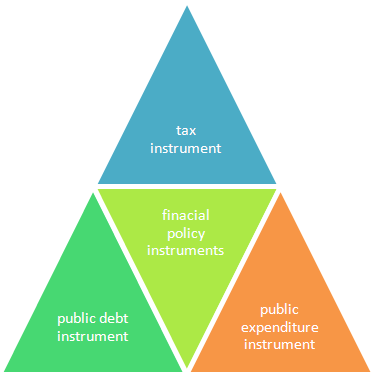 | Figure 1. Financial policy instruments (Source: Prepared by the two researchers based on previous divisions) |
3.2. The Composition of Public Expenditure in Algeria
Public expenditure since the beginning of the third millennium has been steadily increasing, reflecting the expansionist policy of the state, which was aimed at raising the level of economic growth and calculating the standard of living of citizens, based on the increase in oil revenues.
3.2.1. The Concept of General Maintenance
Definition 1: Alimony is defined as: the amount of cash paid by the person to satisfy public needs, government spending takes the monetary picture in exchange for the goods and services you need.Definition 2: The size of the government intervention and the maintenance of the public burden by the state or one of its bodies is one of the most important instruments of economic policy adopted by the StateDefinition 3: "Total uses in the state budget"3.2.1.1. Classification of Public Expenditure in Algeria3.2.1.2. Classification of Budget Steering ExpensesThese are management expenses which are considered necessary for the management of the administrative state agencies, which consists of the wages of employees and maintenance expenses of equipment and equipment, etc.The management expenses are divided into four headings:- Public debt burdens and deductions from revenues- Public Authority assignments- Expenditure on the means of interest- public interventions, and regular expenses consist of expenditure management and manufacturing expenses, and manufacturing expenditure is an expenditure that do not get the state because of its spending on goods and services, but merely a transfer of purchasing power from the state to other destinations and types are:1) Social transfer costs: The state spends to achieve social balance by raising the standard of living of some members of society.2) Economic transfer costs: These are expenditures that are spent on public interest, such as supporting emerging national industries to achieve economic objectives.3) Financial transfer expenses: These are expenses paid by the State. The most important forms are the interest of the public debt and its annual consumption installments, which are based on the principle of annual budget recapitalization3.2.1.3. Classification of Processing Expenses- These expenses are distributed according to the annual development plan of the State. These are the expenditures that open the funds in the annual Finance Law and are allocated to the economic sectors of the State.3.2.1.4. Evolution of Public Expenditure in AlgeriaThe rate of growth of public expenditure or the so-called expansionary policy has increased, as this development is linked to the economic, social and political developments in Algeria.Table (1). Evolution of the size and structure of public expenditure in Algeria for the period 1970-2014
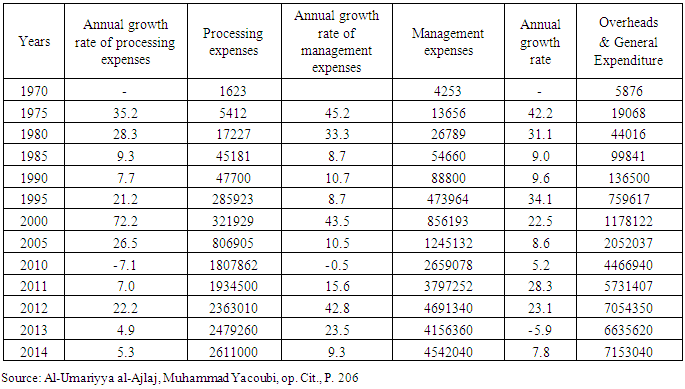 |
| |
|
3.3. Public Expenditure Divisions
One could summarise that public expenditure into the following divisions:
3.3.1. According to the Legal Standard
The classics used the legal standard in the classification of the nature of the expenditure, which depends on the legal nature of the spending, regardless of the nature of this expenditure, if this expense was issued by the people of private law, the maintenance is considered private and if taken from public law people such as: Public expenditure. Depending on the classical legal standard, public expenditure is considered to be public expenditure if it is issued by a public person who is subject to the rules of public law under the sovereignty and power of the State. Thus, the legal standard does not classify expenses incurred by private law persons even if they seek Public utility.
3.3.2. By Functional Criterion
This criterion classifies expenditures on the basis of the functional nature of the person who is the source of the expenditure, so that all expenses issued by the State or one of its bodies do not constitute public expenditure and as a result of the importance of public expenditure in achieving economic and social development from the expansion of expenditure by the State and its various national public institutions And local, without adhering to a specific standard, regardless of the sovereign character or authority.Services are also divided according to the functional criterion:a) Social services expenditures:These include education, health and social welfare, as well as education and scientific research expenses.b) Economic services expenditures:The state aims to create new capital and increase national output, especially in developing countries, due to the weakness of private sector activity. It includes public investment expenditures, which aim at providing basic services such as transport, electricity, water and foreign trade. Agriculture and forest protection costs, as well as tourism support and irrigation and drainage expenses.
3.3.3. According to the Economic Criterion
This criterion is divided into:3.3.3.1. Direct Interview StandardThe direct consideration is what the State obtains either from material funds or services for its public expenses and is a real expense if it has a direct remuneration received by the State.3.3.3.2. Standard for Direct Increase in GNPIt is an expenditure in which the State uses part of the purchasing power to generate new output and additional income directly into society.3.3.3.3. Standard of Direct Consumption of the Economic Resources of the CommunityAccording to this criterion, the real expenditure of the State as a public person directly consumes both the consumption of material in kind, or the use of factors of production and the provision of compensation in the form of wages and salaries.
3.4. Quality of Life and the reality of Housing in Algeria
3.4.1. Quality of Life Standards
There were many definitions and concepts that dealt with the quality of life. The definitions differed in terms of the aspects they dealt with. They were definitions of a psychological, social and economic nature."The quality of life is a reflection of the individual's perception of his status in life, in the light of the cultural context, of the values in which he lives, and in relation to his goals, expectations and interests. The quality of life is a broad concept that is influenced by the individual's physical health, mental state, level of independence, social relations, and relationships with important aspects of the environment in which he lives. " (the world health organization quality assessment; 1995, p. 1403)Lehman defined it as "the sense of well-being and satisfaction that an individual feels under his current circumstances." (LEHMAN, pp. 51-63). According to UNESCO, the concept of quality of life is a comprehensive concept encompassing all aspects of life as perceived by individuals. It extends to the material satisfaction of basic needs and moral satisfaction that achieves the psychological compatibility of the individual through his or her own achievement. “Many countries have set standards and statistics that are directed primarily towards measuring the degree of well-being of individuals' access to social and environmental needs, and providing the information through which indicators are set that determine the quality of life of individuals and communities." (BARRY, 2002, p. 08). On this basis, a set of indicators have been developed that attempt to measure the quality of life of individuals and communities.Vaarima developed a set of indicators divided by their impact on quality of life: (Vaariam, 2007, p.15)- Individual characteristics: age, health, cognitive abilities.- Social factors: family, social networks, social participation.- Economic factors: income, family structure. - Environmental factors: housing, utilities, amenities.- Personal factors: independence, ability to choose, control.The center of Florida has identified objective social indicators of quality of life in: (Borough, 2007, p. 56)- Public Security,- Housing,- Clean the environment- Level of health services,- Provide educational opportunities,- Offering entertainment venues,- Economic level provides transportation and transportation.Figure (2) below summarizes the most important indicators of quality of life, which are economic indicators of wellbeing and empowerment of the individual to live comfortably, by providing job opportunities and thus reducing unemployment, obtaining stable work guarantees income for the individual and his family, and the circumstances surrounding the individual and the place His residence is from an internal environment represented by housing and exterior represented in the environment and facilities necessary for facilitating his life.
4. The Reality of Housing in Algeria
"Housing is defined as" the types of employment and the use of individuals, families and communities for their residential space. It also refers to the ecological framework of the life of a species. The dwelling also refers to an indoor, enclosed and covered place where it lives permanently. (Garzon, 2003, p. 61). Housing is the headquarters and place where the individual spends his or her life and shelter, and must have a set of conditions It is enough space for him and his family members as well as drinking water and Years sewage and all the equipment and the equipment needed to the individual feels comfortable in his home.The Organization of Human Rights and the constitutions of modern countries consider that housing is a legitimate right of the individual. After its independence, Algeria sought to provide housing for its members, who knew a huge demographic increase. The period of independence was only 80 million. In the 1980s, the percentage of demographic growth according to the ONS is 3.5%, which is a significant increase.In light of this situation and in light of the role of the interventionist state, through its various policies, the housing policy and housing expenditure is considered one of the most important social priorities of the Algerian Government and has taken many measures facilitating the purchase of housing in various formulas.
4.1. Housing Policies in Algeria
Residential policy is defined as "a regular set of standards adopted by the state, the main objective of which is to develop the means and mechanisms of intervention in the residential market, and to ensure the overall balance between supply and demand in accordance with the standards of price and Specific quantity ". (AIT AMMAR, 2001, p. 14)The Algerian government has set up a number of measures to facilitate the process of obtaining and acquiring housing. The most important of these measures were the granting of subsidies and assistance to housing applicants, the identification of the beneficiary groups in terms of their socio-economic characteristics or the regions that needed development programs. In their annual budgets by drawing up the processing expenses section.Table (2). Measures related to the housing sector
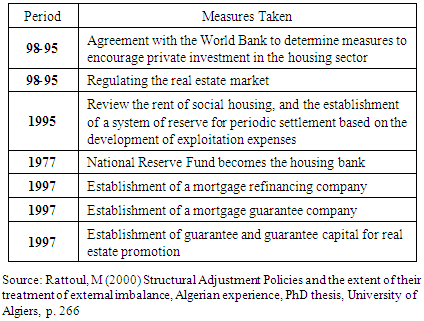 |
| |
|
The most important measures related to the acquisition of housing in Algeria over time can be summarized in:1. Rent Houses: This form of accommodation is directed to categories whose monthly income is 6 times the national guaranteed wage SNMIG, urging that the contribution of the state during the completion period 75% and the contribution of the beneficiary by 25%, paid in the form of monthly rent.2. AADL: A program financed by loans from the public treasury without interest. Its free real estate is between 70 and 85 square meters.3. CNEP's formula: similar to AADL in the nature of housing, but financed by CNEP.4. LSP: This formula benefits individuals whose income ranges from 2.5 to 50 times the value of SNMIG, which is subsidized by the state at a value of 700.000,00 dj,5. Rural housing: The wording and conditions are similar to social housing, but it is only private rural areas.6. LPA: A formula developed in 2011 to compensate for the LSP formula and the formula for sale by rent, the contribution of the State is estimated at 700.000,00 dj.7. LSL: This type of accommodation is intended for low-income people with incomes of up to 2.5 SNMIG, benefiting from 2-room and 3-room accommodation, supervised by the OPCI and the National Housing Fund (TALEB) Kamir, 2017).
4.2. Residential Units in Algeria
During the period from 1962 to 1990, the Algerian government completed 953,347 housing units in various forms. At the beginning of the period, the government paid attention to the completion of housing in rural areas rather than urban areas in order to prove the population in their agricultural lands and to reduce rural displacement. Rural areas in the period 62/66, representing 60% of the total number of housing units. This trend continued until 1978, when it reduced the share of housing in rural areas at the expense of urban areas due to its economic policy encouraging industries and services. -90 Hawalli 782.414 housing units The average annual rate of living during this period was 70,000 housing per year, ie 5800 housing per month. If the government continued at this pace to solve the housing crisis in a short period of time, by the end of the 1980s and the 1990s, Reducing public spending in general and housing subsidies in particular. During the 1990s until the beginning of 2000, it was as shown in Table (3).Table (3). Represents the Residential Settlement Achievement in Algeria from 1962-1990
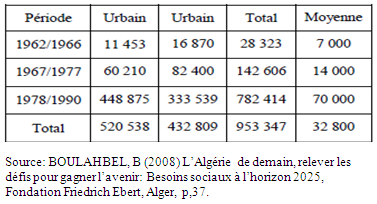 |
| |
|
In order to implement the five-year program for the year 2005-2009, the government allocated 1581 billion dinars for the completion of 1,531,518 housing units distributed between 58.72% for urban dwellers and 41.28% for housing in rural areas as shown in Table (4).Table (4). Represents the Results of Housing Projects Completed from 2005-2012
 |
| |
|
5. Standard Study for Period 1963_ 2017
The standard study is based on statistical data published in the World Bank, especially those related to hope in life at birth, as well as data of the Ministry of Finance on housing expenditure. Therefore, we took the following variables:Espvie: Hope for life:Dephabit: spending on housingFor the period of study is from 1963 to 2017.The analysis will be carried out according to the following methodology:
5.1. Time Series Analysis
All standard studies are in the time series stability test, because the long-term relationship study places the researcher in the problem of time series instability. In the case of instability, the slope that can be obtained is often a false slope. The condition of sleep is essential for the study and analysis of time series to arrive at sound and logical results, and the series is considered if the following conditions are met: (Yt) (Attia, 2005, page 648)2 = Var (Xt) = E (Yt-) Time variance constant 2.The actual value of time Yt-k and Yt between the two values K is that the variable between two values for the same variable is dependent on the time gap Yk = COV (Yt, Yt + k) = E (Yt-) (Yt + k-) in which the variance is calculatedThawabath. Yk 2, the coefficient of heterogeneity والتب and variance, μ where the arithmetic mean,The most important tests that test the stability of the time series:- DICKEY and Fuller unit root test for DICKY FULLER- Acumented Dickey and Fuller- Philips-. Perron Philips Peron Test- (KPSS) Kwiatkowski-Philips-Schimdt-Shin Test- Ng-Perron TestIn our study we will test both adf; pp, kpss, which gave the following results:
5.1.1. Graphical Representation of Variables
By analyzing the graph of the public expenditure on housing during the period 1963-2017, it is clear that there are three stages of housing expenditure. The first phase was between 1963 and 1990, where the prospects were very poor. From 2000 to 2017, where it has seen a great recovery of spending and this is implementing many of the housing schemes for 20 million housing in various formats. The increase in expenditure is due to an increasing rate of two main reasons:- Increase the budget resources derived from petroleum collection.- Population increase by 30.70% and the population of Algeria at the end of 2017 more than 41.5 million peopleFigure 3 represents the evolution of public expenditure on housing from 1963 to 2017.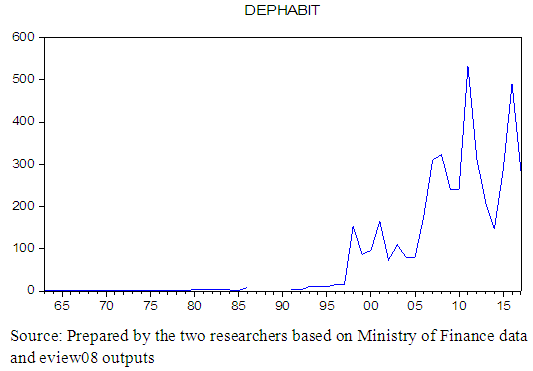 | Figure (3). Represents the Evolution of Public Housing Expenditure from 1963 to 2017 |
As for the expected life expectancy at birth, at the beginning of the period it was very weak, not more than 47 years in the years 1963 to 1970, due to the economic and social conditions of Algeria, the absence of health care and the lack of interest in social development. Life expectancy has been rising from one year to the next, reaching 78 years in recent years, but it is noticed that the rate of hope in women's lives is higher than that of men. This is generally due to men's hard labor, The 1990s and the war of liberation.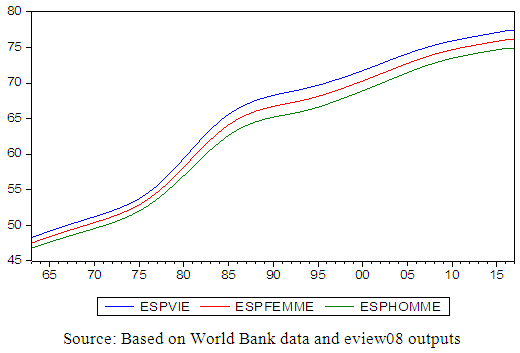 | Figure (4). Represents the Evolution of Life Expectancy in Algeria |
Table (5). Represents an ADF Test for Time-Series Stability
 |
| |
|
The stability of the time series showed that they were not stable at all. 05%.
5.1.2. Linkage Coefficients
The results of correlation between public expenditure on housing and life expectancy gave a high correlation rate of 69.23%, meaning that there is a positive relationship between the variables.
5.1.3. Estimation of the Simple Regression Model
Table (6). Represents the simple regression estimate
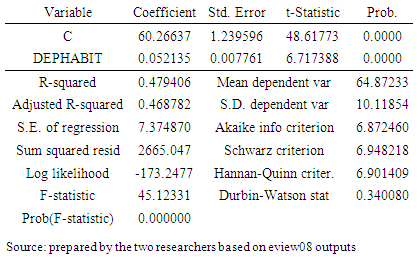 |
| |
|
We estimate the expectation in life by constant C and public expenditure on housing, in the manner of the lower ordinary squares, OLSC = 60.26DEPHABIT = 0.052PROB = 00 parameters are significant because they are less than .05%R = 47.95 The coefficient of bias is the average interpretationPROB FISCHER = 00 Fisher test is significantThe model is estimated as follows: Espviet = 60.26 + 0.052dephabit + UtMeans the greater the spending on housing billion dinars increased the life expectancy of life by 0.052 years, or nearly 19 days.
5.1.4. Test the Nature of the Residue in the Model
Using the jarque berra test, the residues do not appear to be distributed naturally because prob is less than 10%, thus conveying the hypothesis that the residues are not naturally distributed.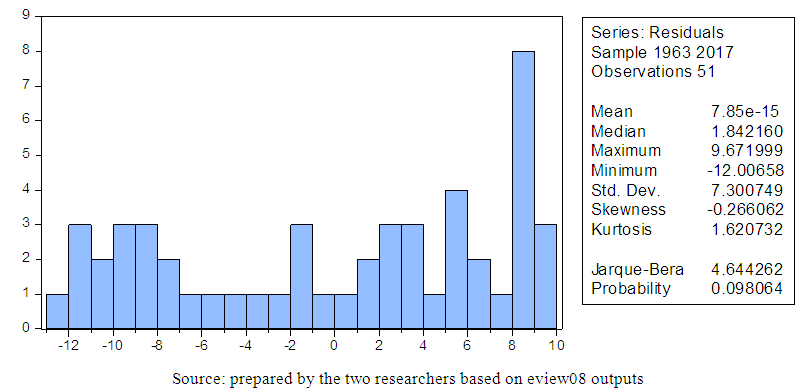 | Figure (5). Represents the Distribution of Residues in the Model |
5.1.5. Self-correlative Test of Residues
Breusch-Godfrey's Self-Correlation Test:¨PROB is smaller than 0 and the model has a self-correlation problemTable (7). Represents the Analysis of Self-Sustainment Problems
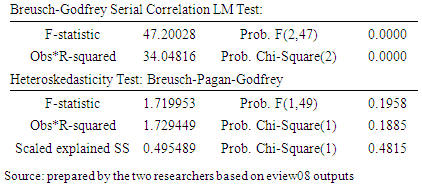 |
| |
|
We then recalculate the model using the GLS method after losing the OLS method- Testing the homogeneity of residual discrepancies where PROB = 0, 19 ie that the residues have the same contrast and therefore the model does not suffer from homogeneity problems. It is estimated the life expectancy in life b public expenditure on housing dephabit and fixed c.Table (8). Represents the Estimate of the Model in GLS format
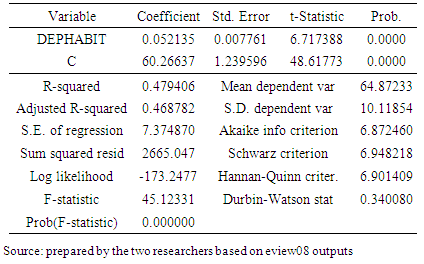 |
| |
|
Regression Equation:- espvie = 60.26 + 0.052dephabit + Ut
6. Discussion and Conclusions
As discussed throughout this study the most important fiscal policy tools, which were varied and the most important of public spending policy was on development. Especially the agreement in the housing sector and its impact on the quality of life and the extent of government intervention and how to organize the expenses according to types of budgeting. Many countries headed towards linking the housing projects as part of QoL requirement in order to address the needs for well-being and ensure the accessibility of individuals to the social and environmental needs services, including housing.We can see from this study that the Algerian Government have facilitated the housing projects in Algeria to address different QoL needs, including AADL, LSP, LPA, LSL. Each project was directed to address specific category of individuals, according to their income. The standard study focused on exploring and analyzing the time-series and then testing the stability of each series by the periods under study. The evolution of Algerian Government spending on housing from 1963 to 2017, was studies based on the data of the Ministry of Finance and Eviews 08 outputs, besides the self-correlation analysis and model recalculation using the lower squares method.We can conclude that the most important outcome of this study are the following:a) The more we have an increase in public spending on housing by one billion dinars we could experience an increase in the life expectancy by 0.052 years, i.e. equivalent to 19 days.b) The correlation between public expenditure on housing and life expectancy is high and is positive.c) Public spending on housing is increasing due to the acceleration of demographic growth which was in 2017, 3.05%.d) The pace of housing completion is slow compared to the demand for housing.e) Algeria is experiencing more increase in the life expectancy at birth than previous periods.In summary, Algeria has made a quantum leap in public housing spending and in financing the development of economic and social programs that had consequences increased social welfare. However, the pace of completion of the housing and speed of its distribution compared to the population increase is slow compared to what corresponds to Maltes theory that the population is growing exponentially in numerical order. Hence, the government despite all its efforts need to ensure that the housing crisis won’t continue, specially through focusing on rectifying the schedule of housing delivery programs. The main limitations of this study is that it totally depended on government published data to make the calculations. Further Studies in this line is highly recommended to help governments in developing countries and specifically Algeria to come up with the best empirically tested policies and regulations.
References
| [1] | AIT AMMAR, k. (2001) Le financeement de la construction de logement en Algérie, mémoire fin d'étude,. Alger: école nationale d'administration. |
| [2] | Al-Aib, W (2010) The Macroeconomic Impacts of the Public Expenditure Policy, A Standardized Implementation Study of Economic Development Models, Hassan Modern Library, First Edition, Lebanon, p 119. |
| [3] | Al-Ajlaj, O and Yaqoubi, M (2016) Analysis of the Quantitative Impact of Public Expenditure on Economic Growth in Algeria, Algerian Journal of Economic Development, No. 05, p. 204. |
| [4] | Al-Dujaili, Q and Al-Farajani, A (2001) Macroeconomics Theory and Analysis, Valletta and Malta, p. 95. |
| [5] | Al-Wadi, M (2010) Organization of Financial Management for the Rationalization of Government Spending and Combating Corruption, Dar Safa Publishing, 1st Edition, Amman, pp. 145-153. |
| [6] | Al-Wadi, M and Azzam, Z (2007) Principles of Public Finance, Dar Al-Masirah Publishing and Distribution, Amman, Jordan, p. 117. |
| [7] | Al-Zahra, F (2016) Governance A Strategic Betting to Streamline Public Expenditure in Algeria, Algerian Journal of Globalization and Economic Policy, No. 07, p. 184. |
| [8] | Attia, P (2005) Modern economics (theory and practice). Egypt: University House. |
| [9] | BARRY, D (2002) Sustainability quality of life indicators toward the integration of economic social and environment measurse. vol11 n04. |
| [10] | Borough, H (2007) County: Quality of Life Indicators Project Florid Center For Community Design Research, University Of South Florid. |
| [11] | Garzon, S. (2003). Chez soi, les territoires de l'intimité. paris: Armand colin. |
| [12] | Karim, P (2009) The Impact of Public Expenditure Policy on Economic Growth - Case Study of Algeria 2001-2009, Master's Thesis, Dali Ibrahim University, Algeria, p. 42. |
| [13] | LEHMAN, A (1988) Quality of life interview for the chronically mentally, evaluation and program planning. Vol 11. |
| [14] | Obeidi, S (2011) The Economics of Public Finance, Dar Dijla Publishers and Distributors, First Edition. |
| [15] | Perkins, D; David, R and Linduaer, L (2008) édition du duveloppement, 3eme édition, édition de Boeck, Belgique, p 496. |
| [16] | TALEB Kamir, A (2017) La politique sociale de l'habitat en Algérie: impacts sur le développement économique et social. Conférence internationale en economie de gestion et commerce international (p. 04). ESMB VOL 9. |
| [17] | Vaariam, M. (2007) Care Patients Quality Of Life. In Haidrum Mollenkopf and Alan Wailker (Ed) Quality Of Life Old Age International And Multi-Disciplinary Perceptive. Social indicators research series vol 31. |
| [18] | WHO (1995) World Health Organization Quality Assessment. Position paper from the world health organization social science medicine. |







 Abstract
Abstract Reference
Reference Full-Text PDF
Full-Text PDF Full-text HTML
Full-text HTML






